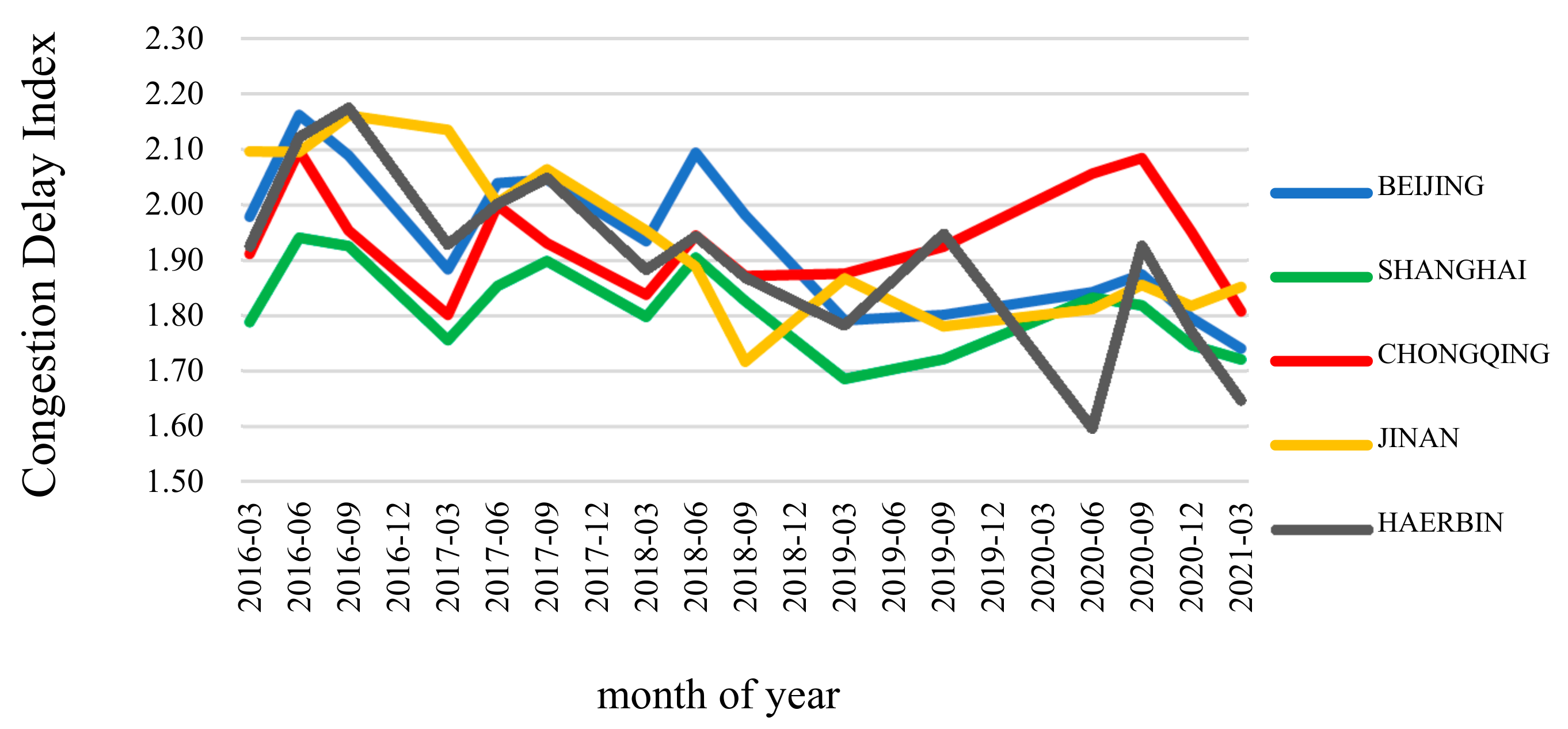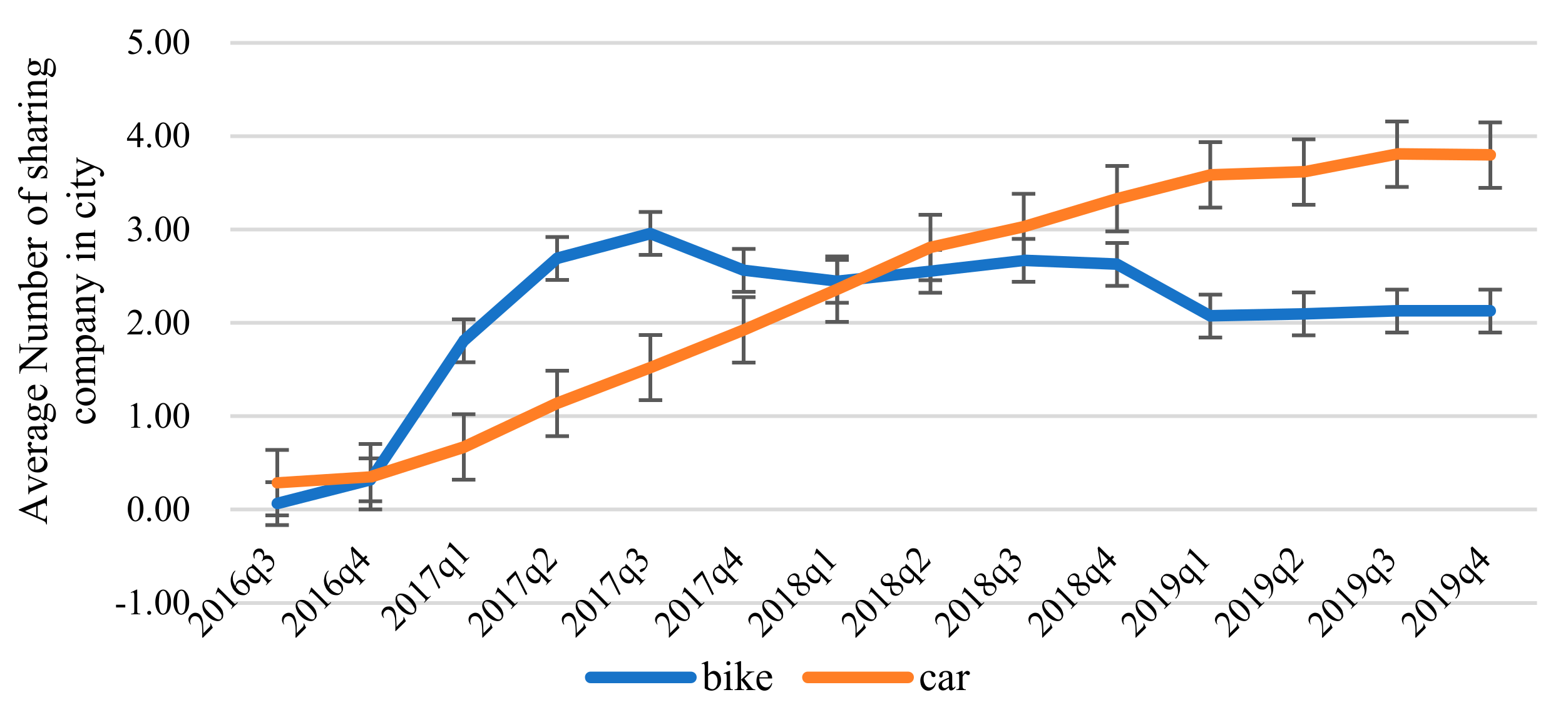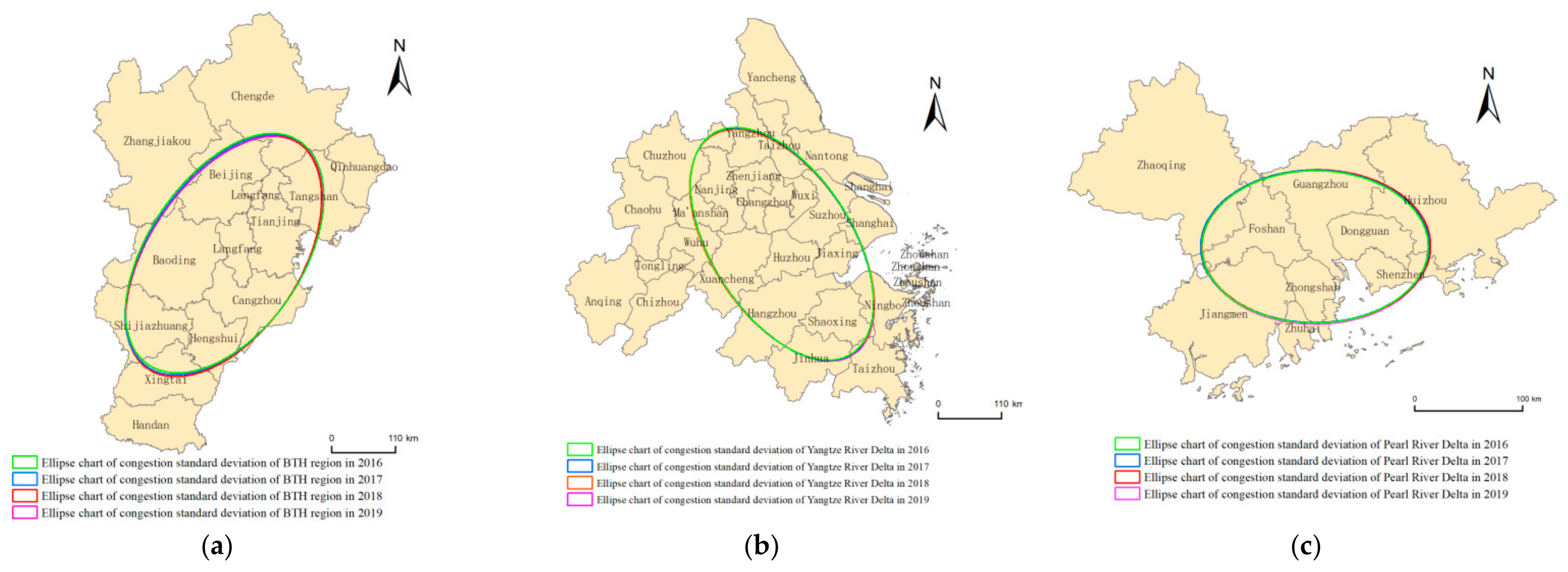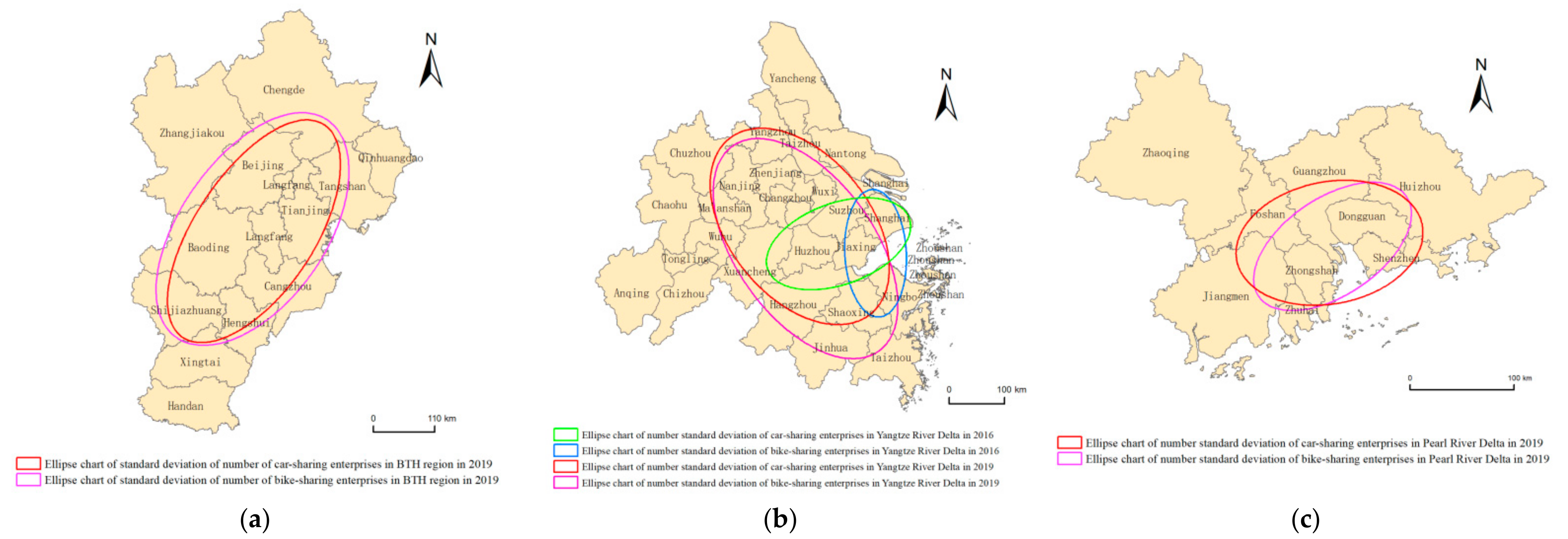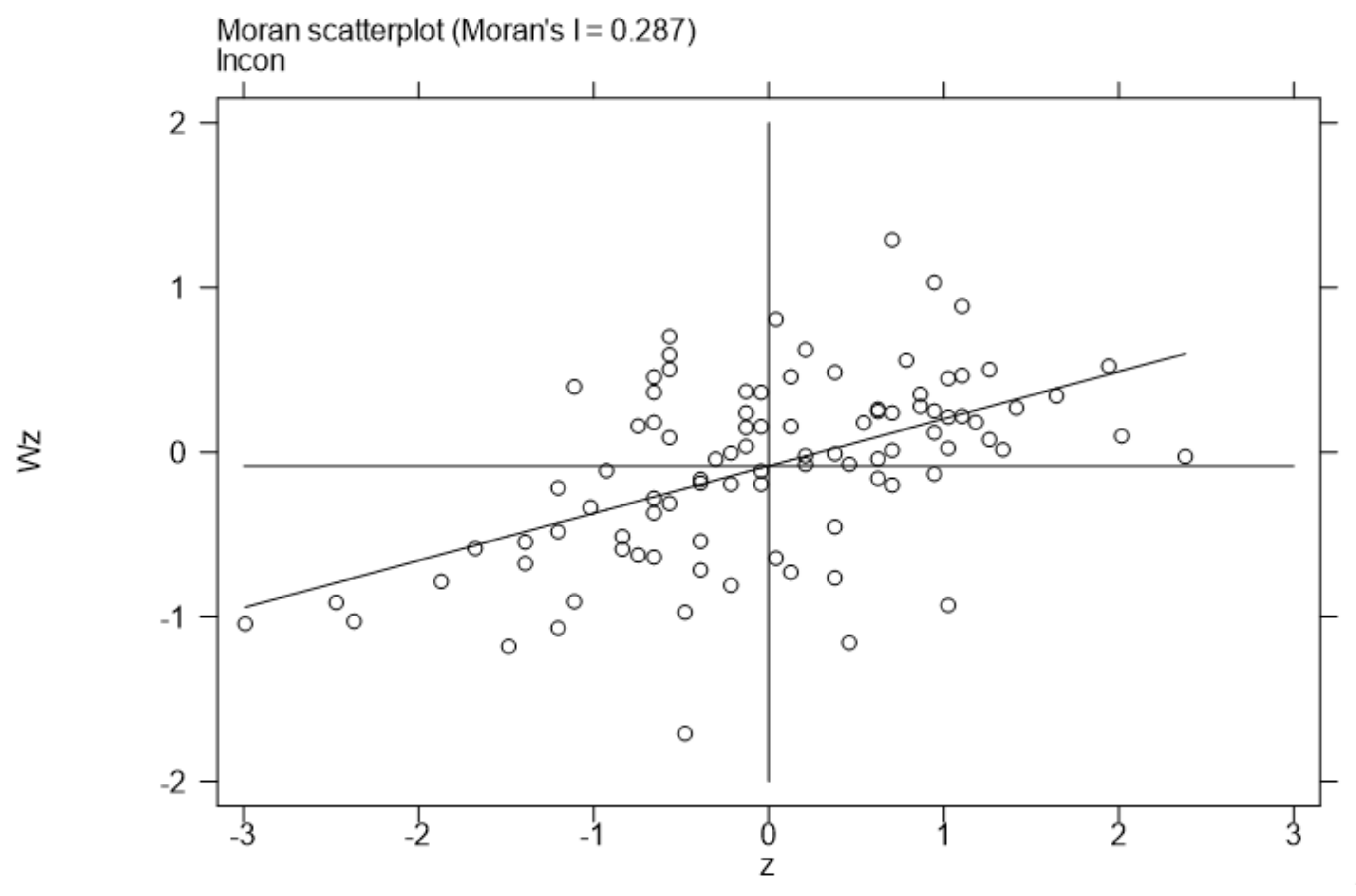1. Introduction
The development of intelligent urban transportation, the use of information technology and the application of artificial intelligence are transforming traffic use. In particular, shared mobility is the intelligent tool most extensively used by commuters and travelers. Various forms of shared mobility have flooded the urban roads and streets to cater to the demand for public mobility [
1]. However, with the rapid growth of shared mobility, a series of undesirable problems has emerged, for example, the excessive allocation of shared bikes has caused resources to be wasted and has seriously harmed the sustainability of public transportation. As such, the reliance on shared mobility to solve traffic problems has faced challenges in large cities [
2]. Whether the development of shared mobility in China can reduce urban traffic congestion and improve the sustainability of transportation is a topic worthy of discussion.
The emergence of shared mobility has been witnessed around the world in recent decades thanks to big data and internet technology. Shared mobility is an important application field that connects intelligent technology, markets, and citizens, and is considered a set of disruptive mobility services and an innovative transportation concept [
3,
4,
5]. Bike-sharing (“BS”) and car-sharing (“CS”) are the two main shared mobility modes in China (The reasons why we excluded ridesharing are as follows. Ridesharing in China is mainly based on individual behaviors carried out on a comprehensive bilateral platform (such as the Didi platform), as a peer-to-peer transaction. The transactions involving shared bicycles and shared cars are based on a separate company, as a business-to-customer transaction. Thus, the data on ridesharing or peer to peer carsharing cannot match with the enterprise-level data on shared bicycles and shared cars. In addition, because ridesharing in China is regulated by the government and the transaction scale is relatively small, being excluded does not affect the basic conclusions of this article.). BS is committed to solving the “last mile” problem of urban commutes through offering a variety of pick-up and drop-off locations. CS provides a convenient, green, and diverse traffic mode, satisfying commuters ‘needs at a much lower cost than car ownership [
6,
7]. According to the statistics, shared mobility expenditure in China accounted for 11.3% of urban residents’ transportation expenditure by the end of 2020. In first-tier cities such as Beijing and Shanghai, approximately 92% of shared bikes can work in conjunction with public transportation (such as subways) faster than cars can for trips shorter than 5 km, demonstrating that BS can effectively improve the transportation efficiency of short-distance travel. In addition, the number of trips by private cars has decreased by 55% (as reported in China’s Sharing Economy Report 2021 by the National Information Centre, and the White Paper on China’s bike-sharing and urban development in 2017). However, due to the excessive expansion and discretionary allocation of CS and BS, some social problems have appeared that generate dissatisfaction and controversy. A large number of bicycles have been parked, and even discarded, without planning. Unpredictable intervals between borrowing and returning shared cars, together with difficulties finding parking space, have dented people’s enthusiasm for using these services.
As people’s willingness to use shared transport has gradually flagged in the face of so many negative issues, the outbreak of Coronavirus in 2020 seemed to have reignited people’s desire to choose this type of traffic service. Considering that coronavirus radically affected people’s travel behavior [
8], some researchers found that the number of people who have continued to choose public transportation since the outbreak of Coronavirus disease 2019 (COVID-19) has dropped significantly, while shared mobility has been less affected [
9]. A survey in Lahore, Pakistan showed that since the outbreak of COVID-19, people have been more inclined to choose a solo mode of travel rather than public transportation [
10]. It can be seen that since the start of the pandemic, people have given new meaning to shared mobility, and they may choose this mode of travel more often.
Traffic congestion has always been the most straightforward means to reflect the efficiency of urban transportation. Continued congestion will seriously affect the sustainable development of transportation. According to the
China’s Urban Transport Report 2020, (which selected 100 cities with serious traffic congestion as the research object; the list can be seen at:
https://jiaotong.baidu.com/cms/reports/traffic/2020annualtrafficreport/index.htm) (accessed on 6 April 2021), 52% of Chinese cities have witnessed a significant increase in congestion that takes a toll on both individuals and society. A report released by Baidu Map in 2018 showed that the economic loss due to traffic congestion in Beijing in 2017 was 4013.31 yuan per capita, ranking first in the country (Data source: China Urban Research Report 2017.
http://huiyan.baidu.com/reports/2017Q4_niandu.html) (accessed on 15 October 2020). According to statistics from the Ministry of Transport of China, the economic loss caused by traffic congestion in China is as high as 250 billion yuan every year (Data source: Shenzhen Kutuo Technology Co., Ltd.,
http://www.szkutuo.com/gongsixinwen/548.html, accessed on 15 November 2021). In the spirit of sharing and sustainability, it is important to alleviate traffic congestion and to promote optimization of the industrial transport structure.
Many scholars and industry experts have focused on speeding up the construction of transportation power and promoting the energy revolution in an intelligent way. Electric power has been selected as the main source of energy in the transportation industry. As China has planned to reach its carbon peak by 2030 and be carbon neutral by 2060, new methods based on smart technology and big data algorithms for transportation have appeared in recent years [
11,
12]. As an application of an intelligent transportation system, the question of whether shared mobility can relieve urban traffic congestion is of critical concern. Considering the impact of shared mobility on city transportation from a psycho-social aspect, it might be combined with the spatial spillover effect of the industry.
First, there is a spatial correlation between transportation industries in geographically adjacent cities. That is, the convenience of a central city will affect its own transportation efficiency as well as the efficiency of surrounding cities [
13]. Therefore, it is argued that the convenience of transportation in a certain city will have an impact on its own transportation efficiency as well as that of the surrounding areas [
14]. The spatial connections between cities are becoming increasingly close. Hence, there is a natural geographic linkage in transportation, especially when large cities such as Beijing and Shanghai act as transportation hubs. High-efficiency transportation will not only promote local economic growth but also boost economic development in surrounding areas through spatial spillover effects [
15,
16].
Second, there is a spatial correlation between the layouts of shared mobility enterprises in geographically adjacent cities. In a city both national operators (such as Harrow Bike and EVCARD) and local operators (such as Renmin shared bicycles in Xiamen city) exist, both of which provide similar shared mobility services. The layout of shared mobility enterprises exhibits spatial agglomeration in cities, especially in megacities and their surrounding areas. Operating shared car or bike enterprises in different cities may also have spatial spillover and spatial correlation. Thus, shared mobility brings about spatial changes in the overall urban transportation structure.
These spatial correlation characteristics provide the basis for the spatial measurement models in this study, which investigates whether shared mobility will affect traffic efficiency in local areas and surrounding areas through spatial spillover effects. Therefore, this paper uses a generalized spatial econometric model (“GSEM”) to examine the spatial correlation between shared mobility and urban transportation. This model will also be used to delve into the internal mechanisms that describe BS’s and CS’s influence on urban traffic congestion, in order to theorize ways to achieve more sustainable transportation. This paper’s unique contributions are as follows: (1) We have systematically collected dynamic data amassed by shared companies from 94 cities that experience heavy traffic every quarter so as to understand the operating status of shared companies in cities. (2) We explore the spatial correlations and spillover effects between traffic congestion and the number of shared mobility companies by constructing a generalized spatial econometric model, both from geographic and econometric perspectives.
2. Literature Review
The existing literature on shared mobility mainly focuses on three aspects: the changes in people’s travel patterns brought about by shared mobility, the relationship between shared mobility and urban traffic congestion, and research methods related to both of these topics.
- (1)
Shared mobility has impacted users’ travel choices. BS has flourished since 2015 and 2016 and provided people with brand-new green traffic modes [
17], which have the potential to become an indispensable part of public transportation [
18]. Yang et al. [
19] found that shared bicycles can reduce transfer time and mileage; Campbell and Brakewood [
20] noticed that the placement of shared bicycles along a traveler’s route reduced bus trips by approximately 2.42%; Macioszek et al. [
21] utilized questionnaires to analyze the operation of shared bicycles and the factors that affected the use of shared bicycles in Warsaw, with results showing that the number of BS system users increases every year and that the users are mainly between 19–45 years old. Moreover, the use of BS is directly related to satisfaction with BS. In comparing the two travel modes (public transportation and BS), the use of BS has increased by 21–35%. People are more willing to use BS for their daily commute. Jin et al. [
22], Cheng et al. [
23], and Fan and Zheng [
24] reached the conclusion that because BS has replaced private cars, road congestion levels around subway stations during peak hours have decreased by 4%. However, Radzimski and Dzicielski, found a positive correlation between the number of bike-sharing trips over short distances (under 1500 m) and medium distances (1500 to 3000 m) and the frequency of public transportation usage, while the number of bike-sharing trips over long distances (3000 m or more) was not related to the frequency of public transportation usage [
25]. Shared bicycles emerged under the influence of new technologies and thus triggered an upgrade of the entire transportation industry. This unique mode also led people to change their travel choices to alternative, more sustainable modes of transportation [
26]. Similar research has also been conducted by Noland and Ishaque [
27], Fishman et al. [
28], and Ahillen et al. [
29].
The studies related to CS focus primarily on the cases of established enterprises. For example, Zhang and Zhang [
30] found that Uber usage has a significant positive correlation with public transport passenger volume. Jochem et al. [
31] analyzed the influence of shared mobility on the travel frequency of cars in 11 European countries. The results showed that one shared car led to a reduction of up to 20 private cars on the road, and this trend increased significantly with higher frequency and travel mileage of CS.
- (2)
In studying the impact of shared mobility on urban traffic congestion, Hamilton and Wichman [
32] reported that a shared bicycle could reduce traffic congestion by approximately 4% in Washington, DC, and this effect is especially noticeable during peak hours in highly congested areas. Wang and Zhou [
33] adopted a difference-in-difference model to achieve similar results by using panel data from 96 cities in the United States. However, with the rapid development of shared bicycles in China, a series of unsustainable issues have been exposed in Chinese cities, including oversupply of BS, discretionary parking and illegal cycling; and inadequate regulations and market supervision [
34]. Mitra et al. [
35] also found that the presence of public bicycles has not changed the mode of transportation for most people, and it is very unlikely that young people will switch from automobiles to bicycle riding. In addition, Chevalier et al. [
36] found that the rapid expansion of BS improved peoples’ cycling activities but it also caused a series of public environmental problems, such as crowding of parking spaces. Therefore, the question of how BS impacts traffic congestion is as of yet unsettled.
In research on CS, Jacobson and King [
37] estimated that if one passenger were added in every 10 vehicles, the potential fuel savings worldwide would be 7.54–7.74 billion gallons per year. Li et al. [
38] found that from 1982 to 2014, Uber’s entry effectively lessened traffic congestion in 101 cities in US through fewer cars, less rush hour traffic and less carbon emissions. Hang et al. [
39] demonstrated that the subsidies distributed by CS enterprises led to an increase in Shanghai’s comprehensive travel index by 0.068–0.078 because CS provides more convenient and economical ride services. In addition, Yuan et al. [
40] utilized big data from the Didi platform and discovered that the rapid increase in the number of CS enterprises reduced travel efficiency on the road, engendering serious traffic congestion and air pollution. In general, both positive and negative effects exist concerning shared mobility and traffic congestion.
- (3)
With regards to research methods, most studies have adopted the traffic congestion fee model and the spatial spillover effect of congestion on the economy. Wang et al. [
41] and Xu and Ou [
42] analyzed the impact of traffic congestion fees on residents’ traffic demand using a traffic congestion fee model and found that congestion fees mainly encourage residents to choose public transportation. Wang and Li [
43] and Li et al. [
44] combined the spatial Durbin model and spatial lag model to study the spatial spillover effects of transportation accessibility on the growth of the manufacturing industry. Jia et al. [
45], by calculating the Moran index, established that there has been a significant spatial spillover effect of integrated transport efficiency in recent years. Existing studies have proved that no single city is responsible for traffic congestion. The infrastructure and economic development of surrounding cities are also held accountable for congestion through spatial spillover effects, especially when economically integrated urban agglomeration is present. In China, these urban agglomerations are mainly the Beijing-Tianjin-Hebei(BTH) region, the Yangtze River Delta (YRD) region and the Pearl River Delta (PRD) region. These regions have high traffic accessibility and obvious spatial spillover effects. Meanwhile, the congestion problems in these regions are also prominent. Therefore, this paper uses these three regions as the research scope to explore the heterogeneity of relationships between traffic congestion and shared mobility in urban agglomerations.
In summary, even though CS and BS change commuting patterns for citizens, the question of whether CS and BS can alleviate urban traffic congestion has not reached a consensus in previous research. Moreover, previous research on BS and CS is primarily based on a single city or single enterprise, with few studies covering larger regions. In addition, the research on transportation by GSEM regarding the effect of change in the internal structure of the transportation industry on traffic congestion and efficiency is insufficient. Therefore, this study intends to adopt the GSEM comprehensively, to consider the operation of two types of shared mobility services, and to evaluate the spatial spillover effects of shared mobility on urban traffic congestion in Chinese cities.
Table 1 and
Table 2 summarize the effects of shared mobility on traffic congestion and the research methods.
3. Materials and Methods
The main purpose of this research was:
analysis of the spatial characteristics of urban traffic congestion in Chinese cities.
analysis of the spatial characteristics of urban shared traffic enterprises.
research on the relationship between shared mobility and urban traffic congestion.
3.1. Variable Selection
The dependent variable reflecting traffic congestion used in this article is the congestion delay index (CDI). This index can evaluate the degree of urban congestion in cities, and it is expressed as a ratio of the actual travel time to the travel time in the free flow state. The higher the CDI, the more serious is the congestion.
Figure 1 shows that the top five highest CDIs of Chinese cities all exceed 1.5, demonstrating that the commuting time of citizens is 1.5–2 times that of free flow.
The independent variable for “BS” and “CS” is the number of operating enterprises in cities, which intuitively reflects the number of shared bicycle and shared car enterprises in operation. If an enterprise went bankrupt in the sample time period, it was excluded accordingly. There are two reasons why the number of BS and CS are not used as independent variables in this paper. First, it is hard to obtain accurate allocation data at the panel level, and it is prohibitive to measure the number of and the usage time of bicycles and cars. (Shared bicycles and shared cars in China belong to independent private enterprises. Those enterprises are unwilling to share data on public platforms to avoid vicious market competition and ethical issues. The total numbers of rentals, customers and vehicles are announced once a year by each shared enterprises but the quarterly data for each city is not released). Second, there is a large discrepancy between the number of allocations and the actual usage of shared mobility, and this makes the effect on traffic congestion inaccurate (The number of allocations refers to the number of shared bicycles and shared cars that are allocated by shared mobility companies in each city; the actual usage of shared mobility means the number of bicycles and cars actually used by riders/commuters, not including the number of idle cars and bicycles). Fortunately, we can obtain the entry and exit times of each shared mobility company in different cities from the company’s official website and city networks in China, so we can assess how many shared mobility companies are in operation each city in each quarter. This is the basic data for our panel data regression.
Figure 2 shows that the number of bike-sharing enterprises increased rapidly and then declined. There are on average more than two shared bicycle enterprises in operation in each city. Shared cars started operating later than shared bicycles, but they have experienced a steady growth. At present, there are on average more than three CS enterprises in operation in each city (The sample source of the data in
Figure 1 and
Figure 2 is consistent with the later econometric model). It can be seen from the length of the error bar in
Figure 2 that the difference in the distribution of shared cars in different cities is larger than that of shared bicycles; and shared mobility has begun to reshape the overall transportation industry in China.
For control variables, drawing on previous studies and considering the availability of data, we found that the factors that affect congestion were multitudinous and complicated. As such, we select seven control variables that have already been proved by previous research as an effective impactor on traffic congestion: (1) The gross regional domestic product (GDP) reflects the development level of the city economy; (2) the regional resident population (RRP) reflects residents’ actual mobility demand; (3) the income of employees on the job (INC) measures the income level in different cities; (4) public mobility passengers (PMP) reflects the scale of public transportation, including the passenger volume of buses, trams and rail transit (subway); (5) the regional vehicle ownership quantity (VOQ) reflects the number of private cars in the city; (6) the regional temperature (TEM) reflects the dependence of climate change on transportation; and (7) the length of the road (LEN) reflects the area’s traffic infrastructure. It is worth noting that road construction, as a kind of infrastructure, is a prerequisite for the capacity of the road network. There are many technical factors, such as road network density and control methods, which will also affect the road network capacity, but this article focuses on the change of traffic mode, so other technical factors have not been considered for the time being. We will briefly discuss these technical factors in the last chapter.
The data used in this paper are collected from China’s Urban Statistical Yearbook, Wind Database, internet news and reports. We use the list of 94 congested cities published by AutoNavi Maps (Amap—China’s leading digital map content, navigation and location service solution provider) as a cross-sectional sample, and this list covers 21 provinces, #four municipalities and three autonomous regions of China, with a time series of 14 seasons from the third quarter of 2016 to the fourth quarter of 2019. Choosing the quarter as data time unit is for the following three main reasons. First, the number of shared travel enterprise layouts changes little at a lower frequency; second, due to the limitations on research conditions, the specific city layout time disclosed by many enterprises is only accurate to the level of month or season; third, seasonal factors may affect people’s use of car-sharing and bike-sharing. For example, the frequency of bike-sharing behavior may be reduced in northern China in winter, so the quarterly frequency can reflect the time fixing effect. The total sample size is 1316. To keep the analysis consistent, a small number of missing values are processed by the moving average method. In addition, to eliminate the influence of heteroscedasticity and dimensional units, this paper performed logarithmic processing for CDI and control variables.
3.2. Model Establishment
Compared with the traditional econometric regression model, the spatial econometric model incorporates the spatial geographical relationship into the model construction and measures the influence of independent variables on the dependent variables under the hypothesis of spatial correlation. Currently, many studies have primarily used the spatial autoregressive model (“SAR”), spatial error model (“SEM”) and spatial Durbin model (“SDM”) [
46]. As the spatial effect of urban transportation may have both spatial autoregressive and random error impacts, this paper adopts a generalized spatial econometric model that includes both the spatial autoregressive effect and random error effect, namely, the spatial autocorrelation model (SAC model). The SAC model is the SARAR model considering time effect. On the one hand, the model reduces endogeneity; on the other hand, it also includes the general situation that the SARAR model considers both spatial autoregressive and spatial error effects. This model comprehensively reflects the spatial effects constructed using spatial autocorrelation and spatial error terms under the condition of panel data. The SAC model is constructed as follows:
In Equation (1), represents the spatial autoregressive coefficient that measures the spatial lag effect; and are k control variables. Equation (2) shows the selection of spatial weight (“”). Considering that traffic congestion is greatly affected by geographical location, geographical distance is selected as the measurement for the spatial matrix and the square reciprocal of spatial geographical distance after row standardization is used as the spatial weight matrix in this paper. Equation (3) shows the generation process of the disturbance term. represents the spatial error coefficient that measures the spatial correlation effect of the error term.
Typically,, as the core independent variables, represent the number of brands of shared bikes and cars in operation in city i at time t. We differentiate the numbers of shared bikes and shared cars because the service forms and the influence mechanisms of the two shared mobility services on urban traffic are quite different.
In addition, we choose the spatial Durbin model (“SDM”) to reflect the spatial effect from neighboring cities, and this model can avoid endogeneity issues. Equation (4) shows the SDM, and
and
indicate the influence of neighbors’ shared bicycles and car enterprises. Variable
and
reflect the spatial proximity effect of shared bicycles and cars.
To address the heteroscedasticity in this model, we adopted generalized spatial two-stage least squares to estimate the parameters so as to improve the robustness of the estimation results. Using Haussmann’s test, we selected a double fixed effects model to eliminate the estimation bias caused by individual effects and time effects.
